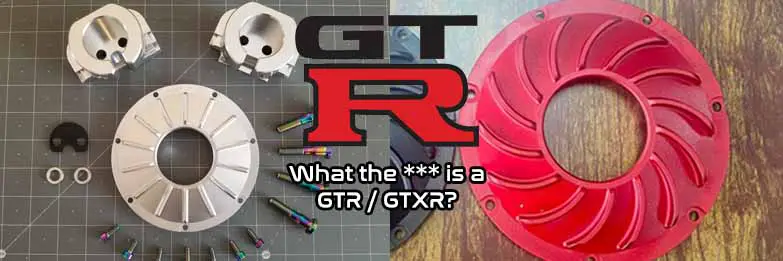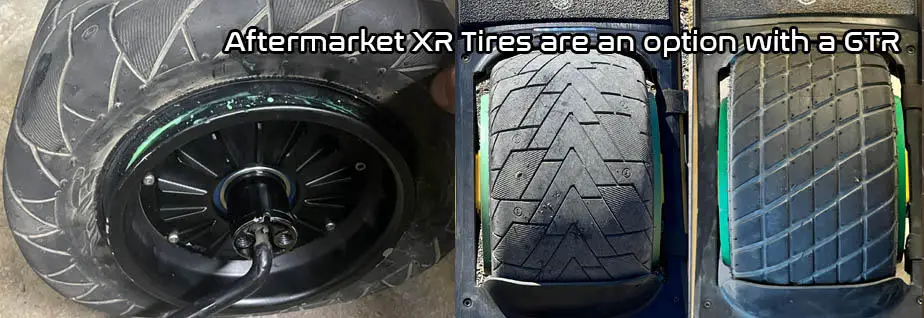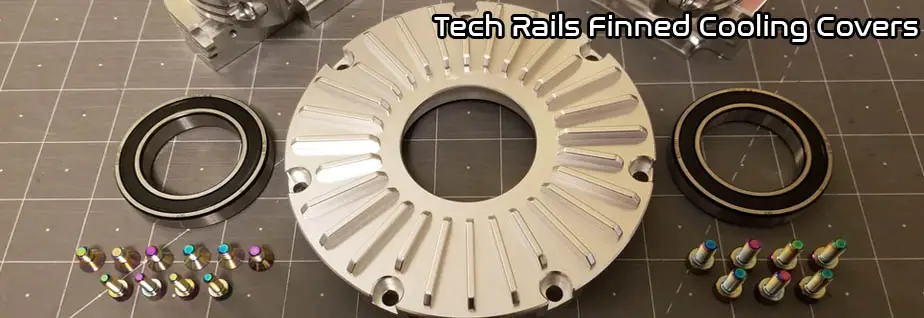
Future Motion currently offers the Onewheel GT as their flagship board replacing its predecessor, the XR. Many riders still consider the XR to offer a superior ride due to the tire size, ride comfort and a Onewheel that is less prone to overheating. How can one get the best of both worlds? Introducing the GTR (a.k.a. GTXR) modification.
The GTR (also known as the GTXR) is a modification made to a Onewheel GT whereby the hub is replaced with an XR hub changing the hub size of the Onewheel from 6.5 inches to 6.0 inches. The variance in hub size is offset by a larger tire sidewall.
The Pros of a GTR Conversion / Modification
Unless aftermarket suspension has been added, suspension on a onewheel is limited to a few components: the tire, tire pressure (PSI), footpads and your legs. You can always reduce PSI, bend your knees or install a foam footpad however you cannot add more tire unless you reduce the size of the hub. There is only so much clearance between the footpads before your tire would rub the footpads. By reducing to an XR hub, the 0.5 inch variance can be traded for tire sidewall height.

Both the GT and XR have the same 11.5″ tire height however the sidewall is larger on the XR because of this smaller hub. While it does not seem like a huge difference, being able to put a half inch more of rubber between the hub and the surface provides for a notable smoother feeling ride. A main gripe with may riders is that the GT’s rubber is harder and more rigid than the XR. Because Future Motion had increased the diameter, there is less rubber to dissipate the shock of the ride. GT trail riding has a more notable ‘bounce effect’ where the wheel often loses contact of the ground.
Reducing PSI to Compensate
Certainly tire PSI is a huge factor in the feel of the ride. Picture an off-road truck tire and a low-profile sports car tire both set to the same low PSI and then picture them hitting a pothole. The truck’s tire is more forgiving whereas you run the risk of damaging the rim on the sports car. This is an exaggerated example however it is meant to show that you can really only go so low in PSI before you run the risk of damaging the hub on a onewheel. Even if the tire is set to the same PSI, you never get the feel of the truck’s tire (XR). The 0.5″ variance in sidewall height is an exponential feeling felt throughout the ride. PSI has limits.
No More Overheating Onewheel GT

The Onewheel GT is more prone to overheating as the hub and rails act as a heat sink for the motor. The heat created by the motor gets dissipated through the hub and rails. Because the GT has a painted rail, the heat gets trapped in the hub area whereas the older XR allowed for the heat to flow to the rails.
Riders pioneering this modification had fabricated their own coverplates. Now, companies such as ‘Tech Rails’ has a CNC aluminum conversion cover plate with built in cooling fins. Now, in hot temperatures and uphill riding, the motor can expel the heat with the fins to avoid overheating. By using a cover plate with fins on it or adding heat sinks, this will allow for better heat dissipation resulting in more power and reliability.
The “Torque” Effect of the GTR / GTXR
Torque is not altered when replacing the hub. Some riders argue that force is increased when converting to a GTXR due to the smaller hub diameter however the same overall tire height (11.5″) does not change. Top speed is also unaffected.
How to Convert the GT to a GTXR / GTR – Materials Needed
Parts needed for the GTXR conversion:
- Conversion cover plate
- XR hub and tire
- Axle carriers
- Remove GT hub from the board’s rails and controller.
- Swap the existing GT stator into the XR hub.
- Bolt the stator onto the new / modified cover plate
- Reconnect the hub to the controller.
- Bolt axel carriers on for the offset (GT and HR hub bolts are not the same). Axel carriers or a similar adapter is needed to align the XR hub to the GT rails).
- Ride
The steps assume you have a tire already on the XR hub. After the swap, the mod should have a more smoother ride. There is a similar modification known as the GTX where the conversion concept is the same however it utilizes a Pint X hub. Either modification you do, this does void the warranty.
With the ability to modify the rails. You can essentially build a GT with WTF homebrew rails and an XR hub. How can a CBXR compete with that?

3 thoughts on “What is a GTR / GTXR – [Onewheel Modification]”